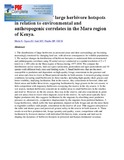The distribution of large herbivore hotspots in relation to environmental and anthropogenic correlates in the Mara region of Kenya.

View/
Date
2012Author
Bhola, N
Ogutu, JO
Said, MY
Piepho, HP
Olff, H
Type
ArticleLanguage
enMetadata
Show full item recordAbstract
1. The distributions of large herbivores in protected areas and their surroundings are becoming increasingly restricted by changing land use, with adverse consequences for wildlife populations. 2. We analyse changes in distributions of herbivore hotspots to understand their environmental and anthropogenic correlates using 50 aerial surveys conducted at a spatial resolution of 5 × 5 km(2) (n = 289 cells) in the Mara region of Kenya during 1977-2010. We compare the distributions across seasons, land use types (protection, pastoralism and agro-pastoralism) and 10 species with different body sizes and feeding styles. 3. Small herbivores that are the most susceptible to predation and dependent on high-quality forage concentrate in the greenest and wet areas and close to rivers in Masai pastoral ranches in both seasons. Livestock grazing creates conditions favouring small herbivores in these ranches, including high-quality short grasses and better visibility, implying facilitation. But in the reserve, they concentrate in browner, drier and flatter areas and farther from rivers, suggesting facilitation by large grazers in the wet season, or little competition with migratory herbivores occupying the reserve in the dry season. 4. In the wet season, medium herbivores concentrate in similar areas to small herbivores in the ranches and reserve. However, in the dry season, they stay in the reserve, and also concentrate in green and wet areas close to rivers when migrants occur in the reserve. As such areas typically have higher predation risk, this suggests facilitation by the migrants by absorbing most predation pressure or, alternatively, competitive displacement by the migrants from preferred habitats. 5. Large herbivores, which suffer the least predation, depend on bulk forage and are the most likely to engender conflicts with people, concentrate in the reserve all year. This suggests attraction to the taller and denser grass and perceived greater safety in the reserve in both seasons. 6. These results reveal how predation risk, forage quantity and quality, water, competition with and facilitation by livestock interact with individual life-history traits, seasons and land use in shaping the dynamics of herbivore hotspots in protected and human-dominated savannas.
URI
http://www.ncbi.nlm.nih.gov/pubmed/22640527http://erepository.uonbi.ac.ke:8080/xmlui/handle/123456789/58242
Citation
J Anim Ecol. 2012 Nov;81(6):1268-87. doi: 10.1111/j.1365-2656.2012.02000.x. Epub 2012 May 28.Publisher
University of Nairobi School of Computing and Informatics
